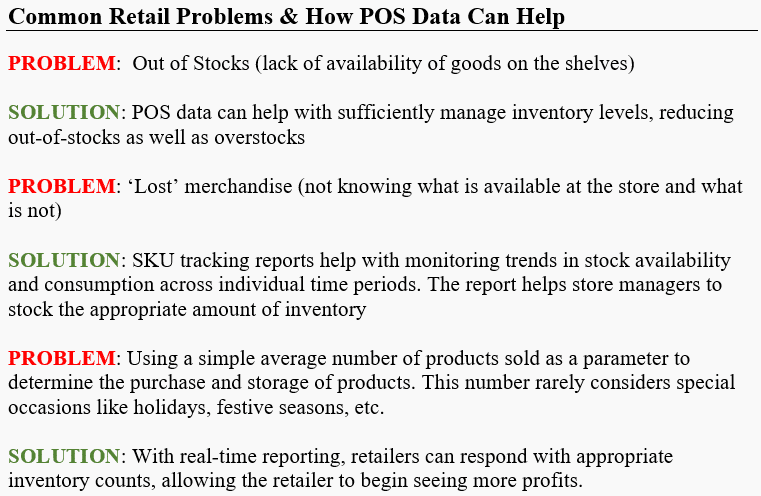POS Data:
More than Numbers
Companies can draw insights about consumer behavior using POS data, which defines an intricate correlation between purchases, inventory, seasons and other contributing factors. These sets of data hold a lot of value, but in raw form, the information can be difficult to work with; after being cleaned up and formatted by a team of analysts, the data can be considered usable.
Inventory Can Make or Break Your Brand
The O-Bomb: Out of Stocks
Out-of-Stock (OOS) is a dangerous phrase among retailers, since it slows sales when real demand strikes. POS data reveals a trend that tells which of the products are in demand at what time during a day, week or year. This helps retailers prioritize stocking the right products in their stores. The biggest advantage you can enjoy as a retailer is to also manage different product categories with enough stock, seamlessly. Hourly sales data with significant gaps during peak sales periods would determine how to tackle with OOS issues to every detail.
Sales Trends
POS data provides the sales and profits earned from each store. optimizing the productivity of a store can help boost the profitability of each store. The comparable data of how revenues are occurring is easily accessible from POS data. It enables productivity at a granular level, which helps to get to the details of each product, category, shelf and store.
Promotional Events
By utilizing POS data to its fullest, retailers can make more accurate decisions in a shorter amount of time. The promotion is optimized to perform well; thanks to POS data reports, management knows exactly what is happening at the points of sale, how consumers are responding to specific promotions, the effects of outside factors like weather, holidays, local events, etc. As more data is gathered and utilized, it is possible to produce calculations of ROI – calculations that can help to plan & execute future promotions. Promotional pricing can be optimized using this data, as well.
Overcoming Challenges in Inventory Management
How Accelerated Analytics Can Help:
SUPPLY CHAIN AND WAREHOUSE MANAGEMENT
Sending your goods to distributors and retailers doesn’t necessarily mean that it will make it into a customer’s cart; events such as returns, exchanges and refunds interrupt the flow of sales cycle. POS data helps predict trends around such interruptions, creating a more unified flow of distribution and sales.
The POS data further helps to gain deeper insights into consumers by analyzing which specific products they are buying and what products are bought together. This information helps retailers plan for future promotions, as well as planning store layout by putting together products likely to be bought together.
RAW DATA IN -> COMPREHENSIVE REPORTS OUT -> BOTTOM LINE SUCCESS
POS data is a gold mine for retailers to understand consumer behaviors and the impact of sales at each store, but even though most retailers collect and store POS data, they don’t know how to make it work for them. Harnessing such large data sets require powerful, deep analysis, so it’s best done using advanced analysis tools. Our predictive and prescriptive software can transform and assimilate POS data and other raw data into actionable insights – insights that will ultimately result in more sales, thus a better bottom line.



